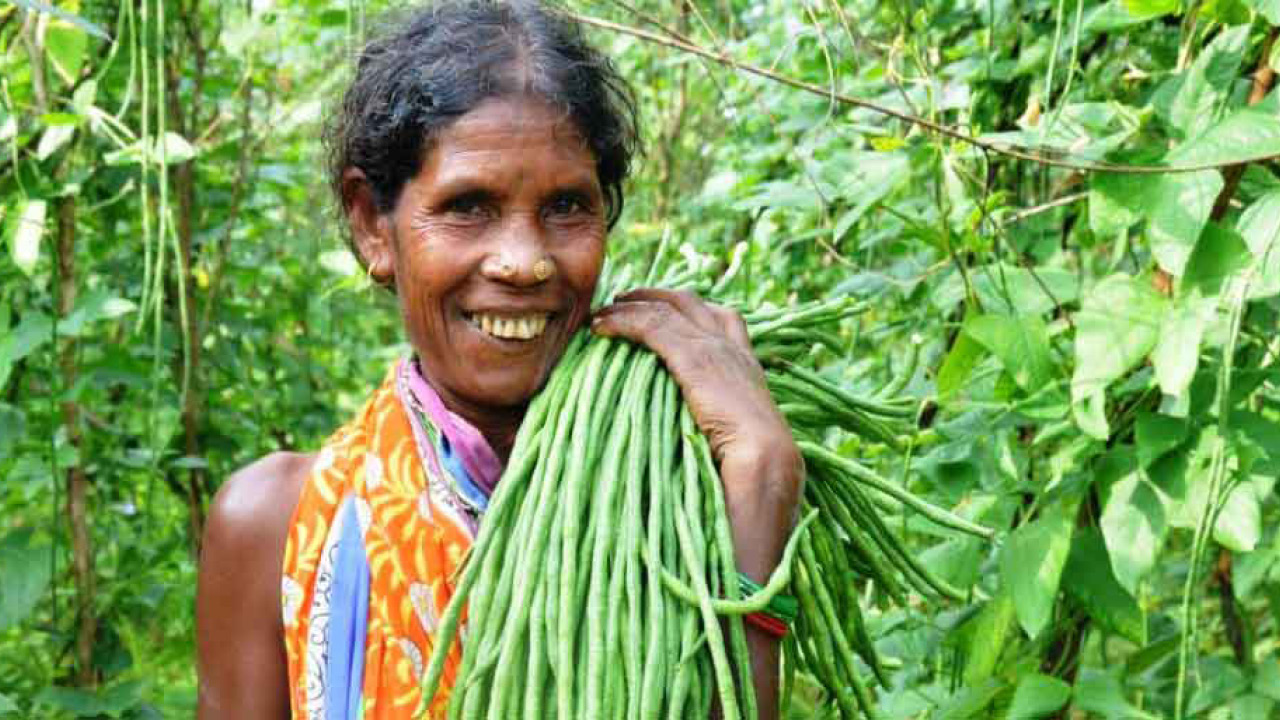Agriculture Production Cluster in Tribal Regions – Directorate of Agriculture & Food Production, Government of Odisha

The project aimed to reach out to 100,000 small and marginal women farmers into 650 Producer Groups (PGs). Within 3 months, 534 PGs were formed covering 54,298 members in 1,320 villages.
Problem
- Marginal farmers living in tribal areas of Odisha suffer from inter-generational poverty
- They do not have access to a variety of livelihood sources
- They are not able to raise enough food for subsistence from forests
- Share of tribal women is low in employment programmes
Solution
- Women farmers were collectivised into producer groups and producer companies
- Farmers were trained to practice synchronized production of identified horticultural crops covering around 40 acres
- Season wise 2-3 crops per producer group are selected looking at market attractiveness, smallholder suitability, and agro-ecological compatibility.
- To augment the livelihoods of the farmers, livestock rearing (Goat, Sheep and BYP rearing) is also being promoted with 40% of the families in these clusters
Outcomes
- Farmers are engaging in livestock rearing and horticulture to supplement their incomes
- Under the livestock rearing initiatives, 12,626 families accessed goat deworming and vaccination services
- A total area of 1,160 acres of irrigation potential was created for 1,853 families to support horticulture and other cultivation activities
- Farmers are growing high-value crops on 9,857 acres of land covering 35,066 PG families
- Multiple income avenues have been generated for the tribal farmers, this has reduced poverty and improved their standard of living
Project Details
Category: State – State Department
Sub-category: Agriculture, Food Processing and Food Safety
Project: Agriculture Production Cluster in Tribal Regions of Odisha
Organisation: Directorate of Horticulture, Department of Agriculture and Farmers’ Empowerment, Government of Odisha
Start Date: 28-Feb-17
https://agri.odisha.gov.in/
Problem
Odisha’s highland regions have a forest-clad undulating topography, dominated by the tribalpopulation. Marginal tribal farmers residing in the region suffer from inter-generational poverty due to low and unpredictable productivity of agriculture, lack of remunerative livelihood sources and declining sustenance from the forest products and livestock. Though women constitute 47% of the labour force in agriculture, there is a need to increase their active involvement in various state livelihood programmes.
Solution
To address these challenges, Government of Odisha launched a special initiative, ‘Agriculture Production Cluster project’ to double the income of one-lakh women farmers by collectivising them into Producer Groups and Producer Companies. Women farmers will cultivate select crops with high market demand, smallholder suitability and agro-climatic compatibility and practice synchronised production. The project aims to supplement the incomes of vulnerable families by promoting livestock rearing. These interventions are augmented by the creation of livelihood support infrastructures like irrigation, plantation, and Goat and Backyard Poultry sheds along with linkage with relevant market players.
Further, this project aims to promote young agriculture entrepreneurs who will be an important part of agricultural services and support the farm-market ecosystem. To achieve the goal, the project focuses on the convergence of required factor conditions in a production cluster mode through multi-stakeholder partnership. In this project, the government orchestrates farm-market-institution partnership, by nurturing Coordination Committees involving relevant departments and NGOs concerned. This collaboration helps in the selection of climate-resilient crops, backward and forward linkage of the farm produces along with value addition at various stages for better profit. The project is also promoting Non-Pesticide Management practices to promote sustainable agriculture and healthy food for all.
Through the APC project, around 100-150 women farmers are organized into Producer Groups (PG), and around 3,000-5,000 women farmers are encouraged to form a producer company. The farmers are facilitated to practice synchronized production of identified horticultural crops covering around 40 acres in a contiguous manner. Season wise 2-3 crops per producer group are selected looking at market attractiveness, smallholder suitability, and agro-ecological compatibility. Besides, to augment the livelihoods of the farmers, livestock rearing (Goat, Sheep and BYP rearing) is also being promoted with 40% of the families in these clusters.
Outcomes
The project aimed to reach out to 100,000 small and marginal women farmers into 650 PGs (Producer Groups). By the end of the 1st quarter of FY 2019-20, the project had initiated the formation of 534 PGs covering 54,298 members in 1,320 villages. In Kharif crops (Till July 2019), farmers were growing high-value crops on 9,857 acres of land covering 35,066 PG families. Producer groups Farmers have undergone training and demonstration on seed treatment, nursery raising, sowing, transplanting, creepers cultivation in trellis, vegetable cultivation in a controlled environment such as poly-house, and greenhouse. The farmers are also engaging in livestock rearing and horticulture to supplement their incomes. The vaccination services for livestock have also been provided as a part of this project.
The project had targeted to achieve 4,800 acres under fruit tree plantation during the FY 2019-20. So far, planning for 1,347 families for a fruit tree plantation covering 1,298 acres has been approved. Under the livestock rearing initiatives, 12,626 PG families accessed goat deworming and vaccination services. Under the irrigation measures till now,15 new Community River Lift points (CRLP) were installed, and 29 defunct CRLP structures were revived. Similarly, 24 Micro River Lift Points (MRLP) (Jalanidhi II) Schemes and 20 Solar Lifts (with District Mineral Funds support) and 13 Cluster Bore wells were installed. A total area of 1,160 acres of irrigation potential was created for 1,853 families.
To conclude, this model of integrating community institutions, government departments, NGOs and market actors in a common platform in a formal manner to uplift the rural poor is working successfully benefiting marginalized communities in the tribal areas.

